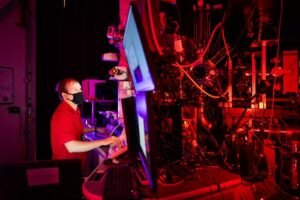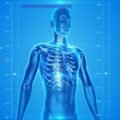Observed for the first time, a phenomenon where metals repair themselves by healing small cracks could upend our understanding of material theories, and may ultimately lead to revolutionary new engineering concepts like self-healing machines.
Researchers at Sandia National Laboratories studying how microscopic cracks form in metals found that under the right circumstances, metals repair themselves, conjuring imagery similar to the famous villain seen in the film Terminator 2: Judgement Day.
Previously, scientists and engineers believed that cracks in metals only got worse over time and that the idea of these complex materials repairing themselves was impossible. If this latest finding can be applied in a practical way, future applications with more complex machines and structures like airplanes or bridges could potentially allow them to heal microscopic cracks before catastrophic failure occurs.
Crack in Metals Are Not Supposed to Repair Themselves
For decades, engineers and scientists who work with metals were confident about two things: metals form microscopic cracks after repeated loads, and over time those cracks can and will grow until they lead to catastrophic failure. Even simulation software used by engineers to develop anything from engine parts to massive structures takes these microscopic, often nanometer-in-size, cracks into account.
The Debrief previously reported on one Terminator-inspired liquid metal “robot” that researchers were able to shape-shift with a magnetic field, but that was a customized type of material and not an everyday metal.
In 2013, Michael Demkowicz, an assistant professor at the Massachusetts Institute of Technology’s Department of materials science and Engineering who is now a full professor at Texas A&M University, started to think that modern science may be wrong and that under certain circumstances, metals should be able to heal these micro fractures. After some research, theory, and simulations, he published his concept in October of that same year.
“We present a new mechanism—discovered using molecular dynamics simulations—that leads to complete healing of nanocracks,” he wrote in the paper’s abstract outlining his simulations.
Now a decade later, a team of researchers working at Sandia National Labs who were simply studying how cracks evolve in platinum stumbled on a real-world version of the phenomenon that Demkowicz had modeled in computer simulations.
MetalS Heal Thyself?
“Cracks in metals were only ever expected to get bigger, not smaller,” explained Brad Boyce, a materials scientist at Sandia Labs. “Even some of the basic equations we use to describe crack growth preclude the possibility of such healing processes.”
Perhaps unsurprisingly, given the myriad examples of accidental discoveries throughout the history of science, Boyce said that their experiments were actually designed for another purpose altogether and that they “certainly weren’t looking for it” when they saw the cracks seem to heal themselves magically.
Instead, Khalid Hattar, currently an associate professor at the University of Tennessee, Knoxville, and Chris Barr, who is now at the Department of Energy’s Office of Nuclear Energy, was running a simple experiment that involved a specialized electron microscope technique designed to pull on the ends of metal 200 times per second. In this case, that metal was a piece of platinum that Hattar and Barr were studying to see how these microscale cracks form under this repeated stress. And then they saw something unexpected that left them stunned.
“About 40 minutes into the experiment, the damage reversed course,” the team explains in a press release announcing the unexpected finding. “One end of the crack fused back together as if it was retracing its steps, leaving no trace of the former injury.”


Although Boyce was familiar with the theory laid out by Demkowicz, he was still shocked to see it actually happen.
“This was absolutely stunning to watch first-hand,” he said.
The stunned scientist immediately communicated the findings to Demkowicz, letting him know that his theory and simulations were right.
“I was very glad to hear it, of course,” Demkowicz said of his initial reaction before successfully confirming on his simulation software that the effect the research team working at Sandi was witnessing was indeed the same one he had theorized.


Practical Application of the Self-Repair Process Offers Challenges and Hope
While the researchers involved are confident in their findings, which were published in the journal Nature, they also caution that applying it in a real-world environment will face many challenges and may not necessarily even be possible.
“The extent to which these findings are generalizable will likely become a subject of extensive research,” Boyce explained. “We show this happening in nanocrystalline metals in [a] vacuum. But we don’t know if this can also be induced in conventional metals in air.”
Still, the theorists and researchers believe it is worth more investigation, and if successful, they see a number of critical potential applications. These include helping bridges, buildings, and other pieces of critical infrastructure last longer and be safer for a longer period of time before needing traditional maintenance. The same goes for aerospace, aviation, and even automotive and maritime engineers, who would likely jump at the opportunity to help the critical components they maintain see dramatic reductions in material failures that, in some cases, end up being fatal.
“From solder joints in our electronic devices to our vehicle’s engines to the bridges that we drive over, these structures often fail unpredictably due to cyclic loading that leads to crack initiation and eventual fracture,” Boyce said. “When they do fail, we have to contend with replacement costs, lost time, and, in some cases, even injuries or loss of life. The economic impact of these failures is measured in hundreds of billions of dollars every year for the U.S.”
Fundamentally, Demkowicz says he is happy to have offered his fellow scientists dealing with the properties of materials a new way of looking at old problems.
“My hope is that this finding will encourage materials researchers to consider that, under the right circumstances, materials can do things we never expected,” Demkowicz said.
Christopher Plain is a Science Fiction and Fantasy novelist and Head Science Writer at The Debrief. Follow and connect with him on Twitter, learn about his books at plainfiction.com, or email him directly at christopher@thedebrief.org.

